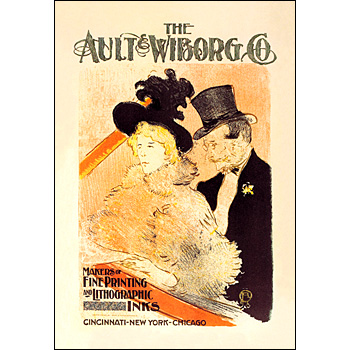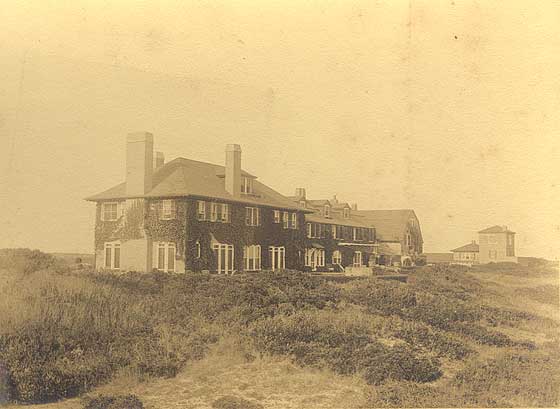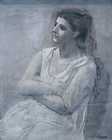 |
 |
|
Sara Sherman, my grandmother, was adopted by her aunt, Adeline Sherman (Mrs. Frank) Wiborg.
|
 |
|

|
| Toulouse Lautrec poster commissioned by Wiborg |
Wiborgs had established a household outside of Cincinnati proper, in the country suburb of Clifton. Frank built a mansion
for his growing family, complete with stables and a sunken garden, at the intersection of Clifton Avenue and Senator Place
-- the latter, almost inevitably, was named after another uncle of his wife's, Senator George H. Pendleton.

|
| "The Dunes" |
In 1895 Frank Wiborg began buying a substantial amount of property in East Hampton on Long Island, NY, including the first
parcels of what would eventually become a six-hundred-acre tract of land that lay between the ocean and a large saltwater
inlet called Hook Pond. There was a gambrel-roofed farmhouse on the property that belonged to the previous owners, a family
named Pell, but it was insufficiently grand for the future that Frank Wiborg had in mind for himself and his family, and he
commissioned Grosvenor Atterbury -- one of the architects of New York's City Hall and of the Metropolitan Museum's American
Wing -- to add onto it. The result was a thirty-room mansion called the Dunes, which grew out of and ultimately subsumed the
original house. When it was finished, it boasted eleven "master's bedrooms" with five baths, nine servants' rooms
with three baths, a ground-floor shower and changing room for swimmers, and a huge living room that was forty-two feet wide
and seventy feet long. Its walls were covered in Currier and Ives prints, marine paintings, and seventeenth-century Beauvais
tapestries, its floors by enormous bear rugs with open mouths, sharp teeth, and lolling red felt tongues, its rooms filled
with enormous dark mahogany furniture. It had stables and pastures and a dairy, Italian gardens and flagged terraces and shady
porches. It was one of the first great summer houses in East Hampton, and it was prophetic: in 1896, the year after Frank
acquired the Dunes property, the railroad was extended to East Hampton, and the town emerged as a fashionable summer resort.

|
|
 |
|
Frank Bestow Wiborg, had been born in Cleveland, Ohio, in 1855, the son of Henry Paulinus Wiborg, a Norwegian immigrant who
was either a deckhand on a lake steamer (as family legend has it) or "one of the pioneer businessmen of Cleveland"
(as the Centennial History of Cincinnati describes him). When Frank was about twelve, his father died; according to the deckhand
legend, he contracted pneumonia while saving the victims of a boat accident, and his widow, Susan, remarried a man with whom
young Frank could not get along. In the best Horatio Alger tradition, Frank Wiborg then reportedly left home to seek his fortune
and found his way to Cincinnati, where he managed to gain admittance to the Chickering Institute, a select college preparatory
academy emphasizing the classics and sciences.
He graduated in 1874 -- in his family's account, he paid his way by peddling newspapers -- and got work as a salesman
for a producer of printer's ink, Levi Addison Ault, and so dazzled his employer that a mere four years later Ault offered
him a partnership in the company. This was the great period of printmaking, when newspaper lithographs, sheet music, poetry
broadsheets, glossy magazines, and posters were the predominant mode of graphic expression, and the new company of Ault and
Wiborg, which manufactured and mixed its own dry color to produce high-quality lithographer's ink, found its product in great
demand, not only in the United States but worldwide. Toulouse-Lautrec was just one of the artists who used Ault and Wiborg
inks for his prints; and the company commissioned him to create an advertising poster, using as a model the beautiful Misia
Natanson, patron and muse of Vuillard, Proust, Bonnard, Faure, and Ravel.
|

|
| Picasso's Woman in White is now at the Met in NYC |
Sara Sherman Murphy (1883-1975) was Sara Sherman's cousin and adopted sister, the second daughter of Frank Wiborg. With her
husband Gerald, she moved to the French Riviera in the early 20th century, where they became the center of a large social
circle of artists and writers of later fame in the 20th century.
Pablo Picasso, a friend of Sara's, painted her in several of his 1923 works:
* Femme assise les bras croisés.
* Portrait de Sarah Murphy
* Buste de Femme (Sara Murphy)
* Femme assise en bleu et rose
|
The Dunes today is covered by multimillion-dollar mansions, golf courses and other markers of Hamptons status crammed onto
some of the world’s most valuable real estate.
|
|
|
|

